|
|
Prepared
presentations***
Art of Particular Time Periods
|
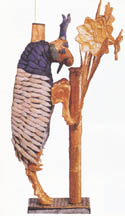
|
The Art and Ideas of the Ancient World
4 part series or any individual class
Explore the ideas underpinning the art and architecture of the ancient
cultures of Mesopotamia, Egypt, Greece and Rome. The region had such a
huge influence on western art it was labeled the Birthplace of
Civilization, but perhaps is now becoming its graveyard. |
|
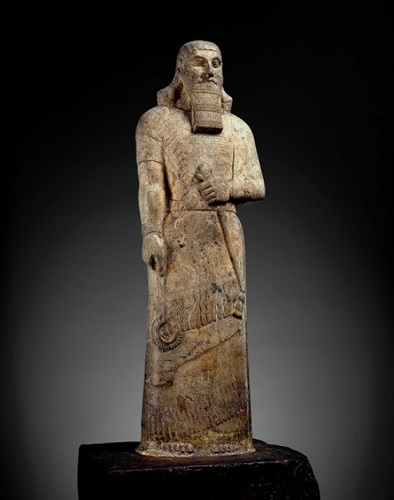 |
Mesopotamia:
Cradle of Civilization
The Iraq war, rise of ISIS, and other
conflicts in the Middle East are causing terrible human
tragedies. There is also a wealth of history that is under
threat of loss or destruction as Iraq, Syria and other countries
in the region are full of world heritage sites, museums, and
archaeolical areas yet to be fully explored.
This illustrated talk will explore the ideas, inventions, and
that led Mesopotamia to be dubbed the birthplace of
civilization. We'll look at the archaeological discoveries that
excited Europe in the 1920s and discuss the challenges the art
and architecture face in the region today. |
|

|
Continuity
Forever:
The Art of Ancient Egypt
This talk will bring
3000 years of ancient Egypt to life in all its glory.
We'll resurrect a people who loved life and worked to ensure they could continue to live
life to its fullest even after death. As Tjaiemhotep urged "Cease not to drink, to get drunk, to
enjoy making love, to make the day joyful, to follow your inclination day and night, do not allow grief to
enter your heart." |
|
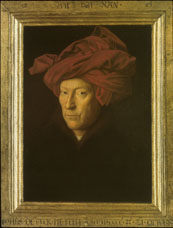
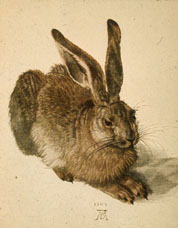
|
Devotion,
Detail and Discovery:
The Mesmerizing Art of Northern Europe
Masters of the 1400s
In Flanders
the development of oil paint by artists like Jan van Eyck led to
paintings with microscopic details of tremendous beauty to
encourage viewers to lose themselves in contemplation of an
image as if they were present at the scene able to touch the
objects and share the emotions of the people depicted.
German art of the 1500s The great
master Albrecht Durer who brought the Italian Renaissance to
Germany but with a northern European twist. We'll focus on
his work but also explore the landscapes of Albrecht Aldorfer,
the powerful religious paintings of Matthias Grunewald and the
brilliance of Hans Holbein the Younger. The Art of the Netherlands, France and Spain
Netherlandish artists like Hieronymus Bosch and Pieter Bruegel
the Elder brought imagination to the northern tradition of
meticulous detail, while artists in France and Spain (like El
Greco) began to adopt the distortions of Italian mannerism.
|
|
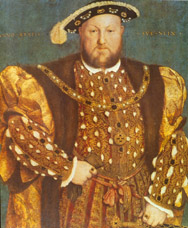

|
British
Accents
A
richly-illustrated survey of art in Britain from the 1550s when
Tudor monarchs hired painters from Europe to the work of
contemporary artists like Banksy. (Can be single session,
or fuller 2 or 3-week series) 16th though 18th centuries Covering many
forms of art, such as portraits by Hans Holbein the Younger
and Thomas Gainsborough, satirical prints by William Hogarth,
porcelain by Josiah Wedgwood and neoclassical architecture by
Robert Adam. 19th century A rich period for British
art. Landscape painting flourished as did the
precisely-detailed art of the Pre_raphaelite
Brotherhood. Whistler advocated art for art's sake while
the Arts and Crafts Movement sought to improve design. 20th century on The modernist ort of
Europe and the horrors of the Woirld Wars impacted British
art. Pop art started in England. The Young British
Artists championed by Charles Saatchi gained exposure and
created controversy while Andy Goldsworthy and others sought
beauty in nature.
|
|
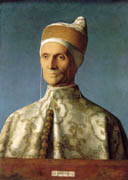
|
Sensuous Poetry: The Art of 16th
Century Venice
Bellini, Giorgione,
Tiziano – even their names are poetic.
Their art was no less so. Venetian
artists revel in the sensuality of color and the glory of the
female form. Compared to the
Venetians, contemporary Renaissance Italians painted only prose.
|
|
Titans
of the Italian Renaissance
(single talk or 3-part series)
The
High Renaissance was a brief - 30 year - tranquil period at the end of
the 15th and start of the 16th centuries when the technical mastery to
produce illusionistic art and the desire to make classically- inspired
art came togther in the hands of profound thinkers.
We'll look at a rich variety of images by Leonardo da
Vinci, Michelangelo, and Raphael while exploring their personal stories
and the times in which they lived as well as their contributions to
art.
Celebrities, courted by princes and popes, these men produced
some of the most influential works of western art.
|
 
|
|
 
|
Art of the Italian Renaissance
(single
talk or 3-part series)
This
talk or series looks at the changes in art as thinkers and artists moved
from focusing on the soul and the spiritual world to an interest in people and the physical
world. That led in turn to interest in the ideas and ideals of ancient
Greece and Rome. We'll explore reasons for these changes and look in
depth at the artists who made the developments that remain at the core
of Western art for centuries.
|
|
 
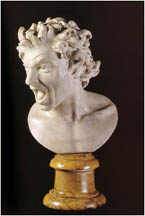
|
Renaissance and Baroque Art
(single
talk or 3-part series)
About 500 years ago
Europe went through a period of exciting change as people awoke to the
wonders of our world and to the ideas and ideals of ancient
Greece and Rome. We will
trace the changes in art brought about by this Renaissance, then go on to
explore the social, religious, and economic reasons causing art to move from classical calm to the dramatic
sensationalism of the Baroque.
We'll try to capture some of the fervor sixteenth and seventeenth
century audiences would have felt confronting the masterpieces created during this era.
|
|
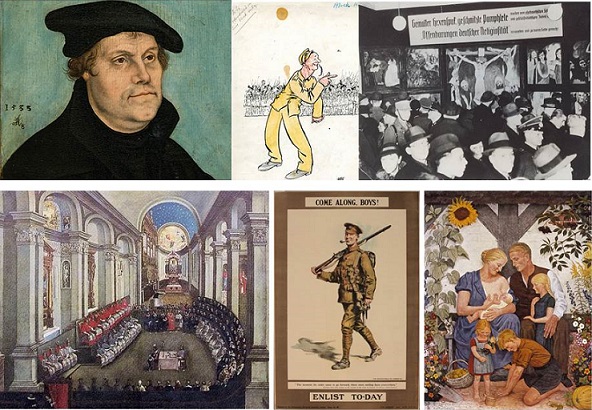 
|
Art in Times of Conflict
(single
talk or 3-part series)
Today
is not the first time art has been destroyed because of beliefs
nor is it the first time art has been employed to promote
political or religious ideas. This series of presentations
explores the role of art in three historical periods.
Art
during the Reformation and Counterreformation
Protestants destroyed art as distracting at best,
idolatrous at worst. The Catholic Church used art to encourage
faith.
Art and World
War I Artists
had official roles in World War I to create recruitment posters
and camouflage, and to spread propaganda, but others used art to
expose the horrors of modern warfare.
Art in the Third
Reich Nazis encourage artists to create art
to celebrate the strength and beauty of Aryans and Germany but
they also used the art they denigrated to promote their
ideology. We'll explore how they used both kinds of art as
propaganda.
|
|
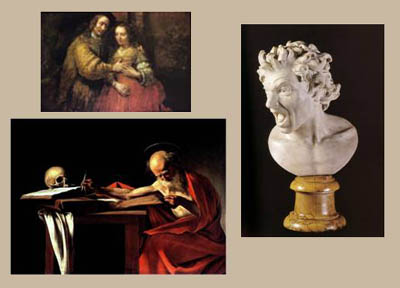
|
Stars
of the Seventeenth Century
Rembrandt, Caravaggio, Bernini
(single talk or 3-part series)
This
series looks in depth at the life and work of three great European
artists, the Dutch master painter and printmaker Rembrandt van Rijn plus
two of his Italian contemporaries, the painter Caravaggio and
sculptor-architect Gianlorenzo Bernini.
All three were immensely skillful and innovative artists whose lives,
like their artworks, were full of drama and emotion.
|
|
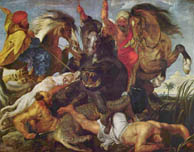
|
The
Sensational Seventeenth Century
Art
in the 17th century moved from the classical calm of the Renaissance to
an art of dramatic sensationalism.
Looking at paintings and sculpture by great masters such as Peter Paul
Rubens and Bernini, this talk discusses why Italian and Flemish art
became so exciting and sensuous.
The Netherlands had its own special style during the 17th century
"Golden Age" of Dutch painting so we'll explore that
also.
Along the way we'll detail the social, religious, and economic reasons
behind these styles.
You don't like Baroque art? I challenge you to look with me before
you make up your mind. This is art at its most accomplished and
most moving.
|
|
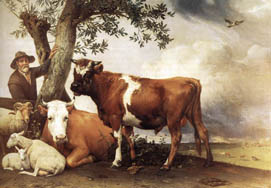
|
The
Golden Age
of Dutch Art
(single talk or 3-part series)
Visitors
to the Netherlands in thew 1600s were amazed at the number of paintings
in Dutch homes and businesses. As a wealthy maritime power the Dutch had
the highest per capita income in Europe. Painting served as a way to
fashion Dutch identity. With artists
like Rembrandt, Frans Hals, Rachel Ruysch, Gerhard ter Borch, Judith
Leyster and Jan Vermeer, this class or classes will be rich in visual
delights.
|
|
The French
Revolution:
Art and Ideas
(single talk or 3-part series)
Changes
in ideas and in society are always reflected in art, but during this
period of intellectual ferment as well as revolution, it also went the
other way around. Art and discussion
about art impacted history.
We'll
see how the seeds of revolution sown in the courts of Louis XIV and
Louis XV and watered by the ideas of Voltaire, the writings of Diderot,
and the paintings of Jacques-Louis David. Our story continues
through the 1789 revolution, the rise of Napoleon, to the final triumph
of republicanism in France.
|

|
|
Century of
Change:
The Art and
Ideas of 18th Century France
This covers
the amazing journey from the art of the French aristocracy at the start
of the century, through the changing ideas about art resulting from the
Enlightenment, the Industrial Revolution, the French Revolution, and the
growing art market.
|
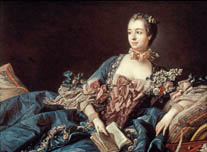
|
|

|
Vive
la France! Vive la
Revolution!
A
fully illustrated look at the revolution in art that
took place in France in the second half of the 19th century. This features artists like Gustave Courbet and Edouard Manet who were the
first to challenge academic traditions, then the younger revolutionaries
like Claude Monet and the Impressionists, and on through rebels, like
Vincent Van Gogh, who followed them.
|
|
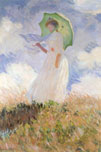
|
Impressionism:
The Art of Seeing
(single talk or 2- or 3-part series)
The Impressionist paintings which are so loved today began in the
rebellion of a few young artists in Paris against the formalism and sentimentality
of academic art in the late 1800s. We’ll
explore the roots of this transformation, look at works by the artists,
like Monet, who are most closely identified as Impressionist, continuing
to artists who fell under the Impressionist spell.
|
|

|
Post-Impressionism:
The Art of Late 19th Century France
(single talk or 2- or 3-part series)
Impressionists
introduced a new way of painting in bright colors to try to
capture the brilliance of outdoor light. Artists after them
tended to retain the vivid colors but reject the idea that art
should quickly and spontaneously just depict the world as it
is. Some, like Gauguin and Van Gogh, wanted a more emotional
approach; others like Cezanne and Seurat, wanted more
structure. This series of three classes will explore the
work and ideas of these and other Post Impressionist artists.
Session 1: The Break with Impressionism
(focus on Toulouse-Lautrec and Seurat) Session
2: Structure or Passion?
(Cézanne and Van Gogh) Session
3: From Natural to Subjective
(Gauguin and the Symbolists)
|
|



|
The
3 Ms who Changed
French Art:
Manet, Monet and Matisse
(single talks or 3-part series)
This
course offers an in-depth look at three great French artists.
Despite harsh criticism by their contemporaries, their rebellions
against the strictures of academic painting succeeded in changing
the course of Western art.
Session
1: Edouard
Manet who sought to update the Old Masters with contemporary
realism, never understanding why his revolutionary works were so
shocking to his contemporaries.
Session
2: Claude Monet who tried to capture the transitory nature of
vision, becoming the father of Impressionism.
Session
3: Henri Matisse who wanted to create a world of harmony and
color, an art of balance, purity, and serenity. His
experiments with color pushed the boundaries of art so far that
even his patron called one of his paintings "the nastiest
smear of paint I have ever seen."
|
|
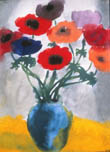
|
Expressionism:
The Assertive Art
(single
talk or 3-part series)
This talk or series delves into the roots
of Expressionism, its flowering in the early 20th century
especially in Germany, and its legacy in Europe and
America.
Expressionist artists often rebelled against contemporary
social values and conventions. They rejected
traditional art forms, colors, and refinement in order to
communicate ideas and emotions in intense paintings,
sculpture, prints and architecture.
Session 1:
Roots and Beginnings (in ancient,
medieval and late 19th century art)
Session 2: Flowering and Forbidden
(early 20th
century German Expressionists)
Session
3: Later and Legacy (after 1914) |
|
Opening
Doors, Opening Eyes:
American Art, 1875-1955
(single talk or 3-part series)
This series explores American art from the critical period when it
adapts to the contemporary world and forges modern ideas about art.
Images shown will range from the realism of Thomas Eakins
to the abstraction of Jackson Pollock and from the urban
life scenes of John Sloan and the Ashcan School to the regionalism of Grant Wood.
Discussion will range from the changes wrought by the
Armory Show and the World Wars to the impact of the New Deal
and the Cold War.
|

|
|
Picturing
America
(single talk or 3-part series)
America's
art tells America's story - the optimism, struggles, humor and pain. We'll explore how people from the
earliest inhabitants to today have pictured the history and landscape of
the country reflecting its ideas and ideals.
Images will range from realistic paintings of John Singleton Copley
to modern abstractions by Jackson Pollock, from the innocent America
captured by Norman Rockwell in his early work to the struggles of black
Americans seen in his late paintings and those of black artists like
Jacob Lawrence, and from inspiring views of unspoiled country by Thomas
Cole to the lonely cities of Edward Hopper.
These artists, and others whose work we'll see, help build our picture
of
America.
|
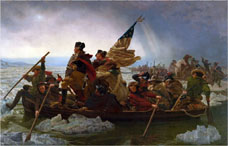
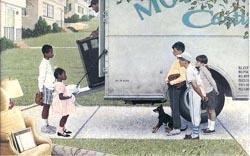
|
|
Unhealed
Wounds:
Art and
the First World War
WWI
was welcomed by artists and intellectuals as the heroic war that would
cleanse society - but it wasn't. It
was the war to end all wars - but it didn't. However
it was a war that still impacts us. Part of that impact comes from its art.
That is the story this talk will tell by looking at paintings, posters,
photographs, sculpture and cartoons from the period.
|
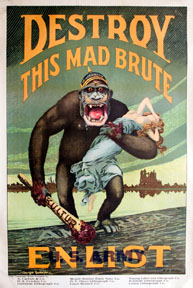
|
|
Art in
the Third Reich
Nazi cultural policies were
inextricably linked to their other goals.
This presentation looks at
art they approved of as well as art they denigrated to show
how the National Socialists used art during the Third Reich to promote
their ideology and further their racial, social, and military
objectives.
|

|
|
Monet
to Dali
This
richly illustrated talk presents artists of the late 19th and
early 20th centuries who changed the course of western
art. It will focus on artists such as Monet,
Cezanne, Van Gogh, Dali and Picasso.
|
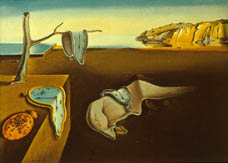
|
|
Painters of Urban
Life: The Ashcan School
In
the early 20th century the cities of America were expanding rapidly with
immigrants from rural areas and overseas creating a lively mix of rich
and poor, parks and tenements. Artists flocked to New York to
teach and to study. This talk focuses on those artists, such as John
Sloan, George Bellows, and Maurice Prendergast who depicted scenes of
life in city streets, parks, and bars.
|

|
|
New
No Longer: Art of the 20th Century
(single talk or 3-part series)
It
was a time of change, a time when art shocked.
We'll
look at the founding of modern art in Europe early in the
century by artists like Matisse and Picasso in France and the
Expressionists in Germany.
Then we'll move to New York for
the flowering of an abstract approach to art, and end by
examining the satirical, often politically- charged art made
later in the century by artists who rejected the formalist
modern approach to art-making.
|

|
General Topics
Art
Topics by Time Period
Talks
Focusing on Special Artists
***
Contact wendyevans@art-talks.org
to get a new topic developed for your group.
top
of page
|